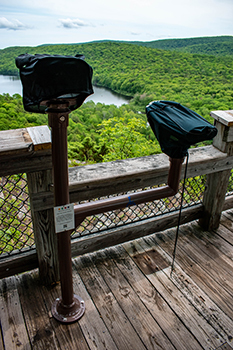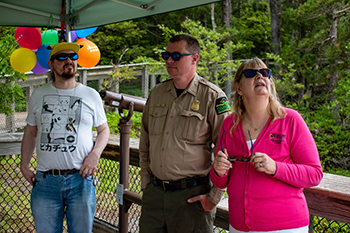Do you see what I see?
New viewers at two Michigan state parks make colors easier to see
By CASEY WARNER
Michigan Department of Natural Resources
For those looking to experience nature’s grandeur, Porcupine Mountains Wilderness State Park in the western Upper Peninsula – fondly known as “the Porkies” – is the place to go.
Featuring 60,000 acres of old-growth forest, roaring waterfalls, Lake Superior shoreline, rivers, trails and ridges, the park’s incomparable vistas make Michigan’s largest state park a popular destination for outdoor enthusiasts.
The Porkies’ scenic views at natural attractions like Lake of the Clouds and Summit Peak draw many visitors, but some people haven’t had the opportunity to see these sights as vibrantly as others – until now.
In June, the Michigan Department of Natural Resources Parks and Recreation Division unveiled specially adapted scenic viewers at Porcupine Mountains Wilderness State Park that offer people who are colorblind a tool to enjoy the full spectrum of colors at the park for the first time.

The viewers, made by SeeCoast Manufacturing, have filters produced by EnChroma, a company that manufactures eyewear for colorblindness.
EnChroma’s specially engineered lenses enable people who have red-green colorblindness to see color more clearly, distinctly and vibrantly.
The lenses contain optical filters that remove small slices of light, which helps compensate for excessive overlap in the photopigments in the eye and enhances the vibrancy and saturation of colors while facilitating color discrimination, depth and perception for people who are colorblind.
The company has launched International Color Blindness Awareness Month in September, “to educate the world about the impact color vision deficiency has on people at work, in school, and in fully appreciating art or the colors of nature,” said Erik Ritchie, CEO of EnChroma.
Missing some of nature’s true colors
One in 12 men and one in 200 women, about 425,000 people in Michigan and 13 million in the U.S., have colorblindness. While people without colorblindness see over one million hues and shades, people with colorblindness see only about 10% of them.
To people who are colorblind, some colors are indistinguishable. For example, purple and blue look the same, red appears brown, pink looks gray and green seems brownish or gray.
Numerous state and national parks, including 13 Tennessee state parks, have already offered the EnChroma technology to help enhance colorblind visitors’ outdoor sightseeing experiences.
Porcupine Mountains Wilderness State Park manager Mike Knack learned about Tennessee’s efforts and thought visitors to the Porkies would benefit from similar technology.
“When I first heard about these viewers, I knew I needed to get them for our park,” Knack said. “Really the mission was to be able to let everybody who has colorblindness be able to see what everyone with normal eyesight and normal vision can see – the spectacular views all across the Porkies in the Western U.P.”
|

Adding this new technology for those who have colorblindness is part of a larger effort to make the park accessible for visitors of all abilities.
“The Porkies is such a special place, and we want everyone to enjoy it,” Knack said. “This is just one more way we can bring everybody into the park, and they can all enjoy and experience the park in a similar way.”
Introducing new technology for visitors who are colorblind
The viewers have been installed at the park’s three signature attractions:
- Lake of the Clouds Scenic Overlook: Surrounded by the silhouettes of the Porcupine Mountains and overlooking thick forest, Lake of the Clouds is the most photographed feature in the park, and one of the most photographed in the entire Upper Peninsula.
- Summit Peak Observation Tower: The highest point in the park, at nearly 2,000 feet above sea level, this 50-foot tower offers spectacular views. On clear days, visitors can see the Apostle Islands to the northwest and Isle Royale to the northeast.
- Nawadaha Falls: There is a viewing platform for guests to enjoy Nawadaha, one of three beautiful waterfalls on the Presque Isle River, located on the western edge of the park.
Both the falls and the Lake of the Clouds Scenic Overlook have two viewers, one of which is at a height suitable for wheelchair users.
Friends of the Porkies, the nonprofit support group for the park, raised money to finance the purchase of the five accessible viewers. The total cost was about $17,000.
|

“I think it’s going to open up a world of possibilities for visitors to the park,” Sally Berman, president of Friends of the Porkies, said. “The fall colors in the Porkies are definitely some of the best in the state of Michigan, because we have such a mix of deciduous trees and evergreens — so we get golds and reds and oranges and burgundies mixed in with that dark, dark green. Being able to experience the fall color here is one of the highlights of the year.”
Opening the door to a more colorful world
At the unveiling of the viewers in June, three guests with colorblindness came to the Porkies to check them out. They also had the chance to try on EnChroma glasses that use the same technology as the viewers.
Justin Farley, a 43-year-old park ranger at Porcupine Mountains State Wilderness Park, said he has moderate colorblindness and has trouble distinguishing borders when painting and tracking blood from animals hunted, mostly on green grass. He said he hopes the EnChroma glasses will enable him to better trail game when hunting and that they make it easier for him to distinguish colors when looking at trees.
"The colors are a lot more pronounced. Without the glasses, everything just appears green. But with the glasses, the oaks and maples are a certain green color. And also, the pines and cedars are a lot darker of the green. It's easier to differentiate the colors with the glasses," Farley said.
Joshua Smith, 43, is a hotel front desk clerk and artist from Marquette who said that he was teased growing up when he couldn't see colors correctly.
“It makes it hard when I am searching for colors when doing art because it is hard to find the right color. I also have trouble when looking at color-coded things," Smith said.
He hopes the EnChroma glasses will enable him "to see the colors I'm missing out on. I would like to experience how it will affect my art and see things that people often say are beautiful, like the northern lights, which I really can't see that much."
Patty Steingberg, 66, is a retiree from Crystal Falls who was diagnosed with colorblindness in her 20s. She said that she has always relied on a sibling or spouse to help match her clothes and that she has yearned to see the vibrant colors of the outdoors.
|

“If you’re colorblind, and you wonder what you’ve been missing, you should come and look at the viewfinder and see what you’ve been missing,” Steinberg said. “It was awesome. I saw colors and hues I’ve never seen before.”
Berman said she was thrilled to see the visitors use the adaptive technology.
“When I heard the comments from those three people who were using the viewers and the glasses for the first time, I had tears running down my face. Tears of joy,” Berman said.
Building on DNR’s accessibility, equity and inclusion efforts
The specialized viewers aren’t available only at the Porkies. An EnChroma-enabled viewer also was recently installed on the Skyline Trail at Ludington State Park in Mason County, thanks to the Friends of the Ludington State Park.
Jim Gallie, Ludington State Park manager, said the Friends group came to the park staff with the idea after the organization’s president, Patrick O’Hare, learned of it at the DNR Parks and Recreation Division Friends Group Summit.
“He was surprised to learn of the prevalence of color blindness in the population and thought that it would be a great addition to our accessibility improvements at the park,” Gallie said. “We opted to place it on the Skyline Trail since that location has such expansive views to the south. In the future, we are looking at placing additional viewers at other locations in the park, such as along the Island Trail looking out over Hamlin Lake.”
The specialized viewers for visitors who are colorblind are part of the DNR’s goal to expand accessibility, equity and inclusion.
“Over the years through feedback from the department’s Accessibility Advisory Council, passion and fundraising from local state parks friends’ groups, and a commitment of improving existing facilities from park planners and managers, the DNR has made significant strides to improve amenities and facilities for people of all abilities,” said Dan Lord, acting assistant chief of the DNR Finance and Operations Division.
Lord also serves as the executive sponsor for the Accessibility Advisory Council, which provides guidance to help the DNR develop, manage and plan opportunities for those of all abilities to enjoy Michigan’s natural resources.
“The technology that’s been incorporated at Ludington State Park and the Porcupine Mountains Wilderness State Park allows more people to experience the amazing colors of the natural resources that these two amazing locations have to offer,” he said.
Since this story was published, two new EnChroma-enabled viewers were added to the top of the newly opened berm in Milliken State Park and Harbor in Detroit. The beloved hill reopened with safer and more accessible pathways that will also help protect the soil from future erosion issues. These viewers, courtesy of the Detroit River International Wildlife Refuge and EnChroma, enable visitors to view the river and our neighbors in Canada through two new spotting scopes.
For more information about the wide variety of accessible recreation opportunities the DNR offers at state parks, campgrounds, boating access sites, state game areas, trails and more, go to Michigan.gov/DNRAccessibility.
|
Check out previous Showcasing the DNR stories in our archive at Michigan.gov/DNRStories. To subscribe to upcoming Showcasing articles, sign up for free email delivery at Michigan.gov/DNR.
Note to editors: Contact: John Pepin, Showcasing the DNR series editor, 906-226-1352. Accompanying photos and a text-only version of this story are available below for download. Caption information follows. Credit Michigan Department of Natural Resources, unless otherwise noted.
Text-only version of this story.
Crayons: A comparison view of crayons under normal color viewing and color-deficient viewing. (Photo courtesy of Enchroma)
Group: A group of three people invited to try out the new viewers for visitors who are colorblind at Porcupine Mountains Wilderness State Park look through special sunglasses that use the same technology. From left, Joshua Smith of Marquette, park ranger Justin Farley and Patti Steinberg from Crystal Falls.
Ranger: Justin Farley, a park ranger at Porcupine Mountains Wilderness State Park, said colorblindness gives him trouble distinguishing borders when painting and tracking blood from animals when hunting. In this image, he looks through one of the new viewers for visitors with colorblindness at the park's Lake of the Clouds Scenic Overlook.
Sign: A sign posted at the Lake of the Clouds Scenic Overlook at Porcupine Mountains Wilderness State Park describes the viewers for park visitors who are colorblind.
Viewers: Two viewers for people with colorblindness, one positioned to allow viewing by park visitors in wheelchairs, are pictured at the Lake of the Clouds Scenic Overlook at Porcupine Mountains Wilderness State Park in Ontonagon County.
Visitor: A park visitor looks through one of the viewers for people who are colorblind at Porcupine Mountains Wilderness State Park in Ontonagon County.
|